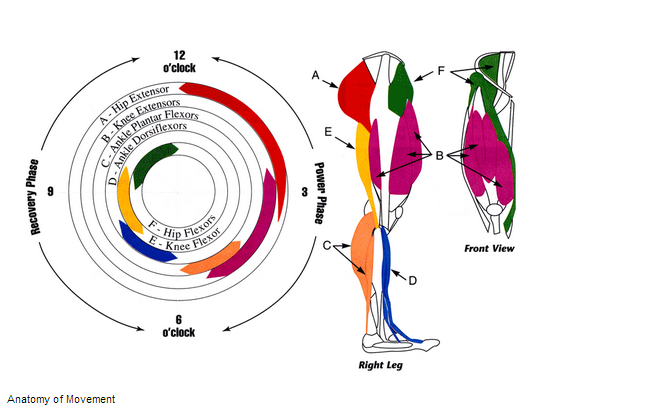Cycling Biomechanics
Original Editor - Your name will be added here if you created the original content for this page.
Top Contributors - Michelle Lee, Lucinda hampton, Evan Thomas, Wanda van Niekerk, Kim Jackson, Vidya Acharya, Laura Ritchie, Scott Buxton, Naomi O'Reilly and WikiSysop
Introduction[edit | edit source]
Cycling was initiall invented by Baron Carl von Drais in 1817, but not as we know it. This was a machine which intailed two wheels which were connected by a wooden plan with a rudder device for steering, that involved people running along the ground whilst sitting down; giving them the name of a 'running machine' (in all senses) or a velocipied. This was solely used by the male population at the time of invention. The velocipied then made a huge design development in the 1860's where Michaux factory in Paris. They added leaver arms to the fron wheel which were prepelled by pedals at the feet. This was the first conventional bicycle, and since then up until the current day the bicyle has made great design and technological advances. [1]
A survey in 2014 estimated that over 43% of the United Kingdom population have or have access to a bike and 8% of the population aged 5 and above cycled 3 or more times a week. [2] With such a large amount of people cycling, whether it be professional, recreational or for commuting this increase the chance of developing an injury, so it is time we understood the biomechanics of cycling.
3 Points of Contact[edit | edit source]
There are 3 points of contact in cycling. Meaning 3 points of the body that make contact with the bike:
- Pelvis on the saddle
- Hand on the handlebars
- Foot on the pedal
Something to be aware of is that these areas can undergo sustained amounts of pressure and compression which can cause numbness, pain and weakness. [3]
Phases of Cycling / Pedaling[edit | edit source]
There are 2 main phases of the pedal cycle; the power phase and the recovery phase. If you imagine the pedal cycle as a clock phase and you start with the pedal at 12 o'clock, this is known as Top Dead Centre (TDC). The pedal is then pushed down from 12 until 6 o'clock, this position is known as Bottom Dead Centre (BDC). The pahse between the 2 is known as the Power Phase where all the force is generally generated to propell the bike forward.
The transition from BDC back upto TDC is known as the Recovery Phase. Now not all of the muscles switch of during this phase, it just is not as active as the Power Phase.
If you look at the image you can see what muscles are working at which points during the pedal cycle.
Anatomy of Cycling[edit | edit source]
There are many components that are working whilst cycling this is not just a sport of the lower limbs. Below the areas of anatomy have been broken down to provide more detail on what is happening and when.
Pelvis, Hip and Knee[edit | edit source]
The pelvis is the start of the lower limb complex, and is compromised of the ischium and the ilium. The ischial tuberosities (also referred to at the sitting bones) are located here and play an important roll for the hamstrings, as this is where all three origionate.The hip is also an important anatomical feature as this is a large 'ball and socket' type joint, which allows for a large degree of multidirectional movement. During cycling the hip allows for and guides hip felxion, extension and small degree of rotation. Further down the lower limb complex the knee is situated. This 'hinge' joint and acts as a lever to the femur, as as the femur is the longest bone in the body this can create large amounts of torque. The patella which
The hip and pelvis' ability to create a large amount of torque is astonishing.
The main role of the hamstrings is knee flexion but they also assist hip extension. During cycling depending on the position that is adopted by the cyclist if on an upright bike, the ischial tuberosities may take most of the load through the saddle.
[edit | edit source]
Recent Related Research (from Pubmed)[edit | edit source]
Extension:RSS -- Error: Not a valid URL: Feed goes here!!|charset=UTF-8|short|max=10
References[edit | edit source]
References will automatically be added here, see adding references tutorial.
- ↑ History of Cycling. (accessed 24th May 2016) http://cycling.isport.com/cycling-guides/history-of-cycling
- ↑ Cycling UK Statistics. (accessed 24 May 2015) http://www.cyclinguk.org/resources/cycling-uk-cycling-statistics#How many people cycle and how often?
- ↑ Burt P. Bike Fit. Bloomsbury: London. 2014
- ↑ Cycle Season is Here in Vancouver, How is your Pedal Stoke? http://www.mypersonaltrainervancouver.com/cycle-season-is-here-in-vancouver-how-is-your-pedal-stroke/ (accessed 27 May 2016)







